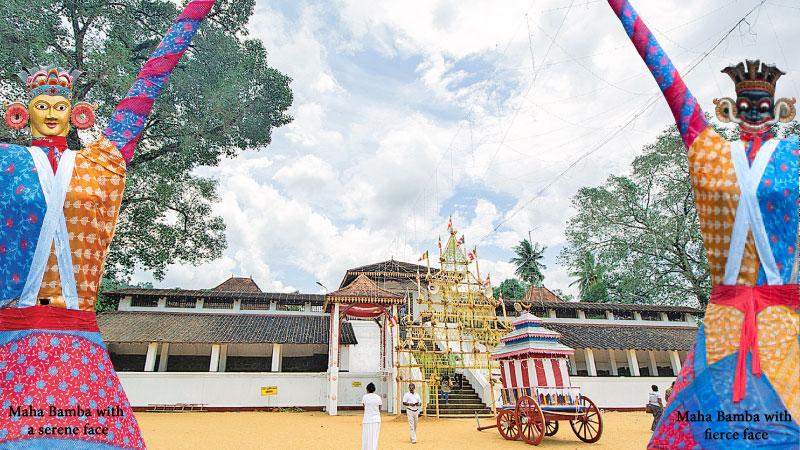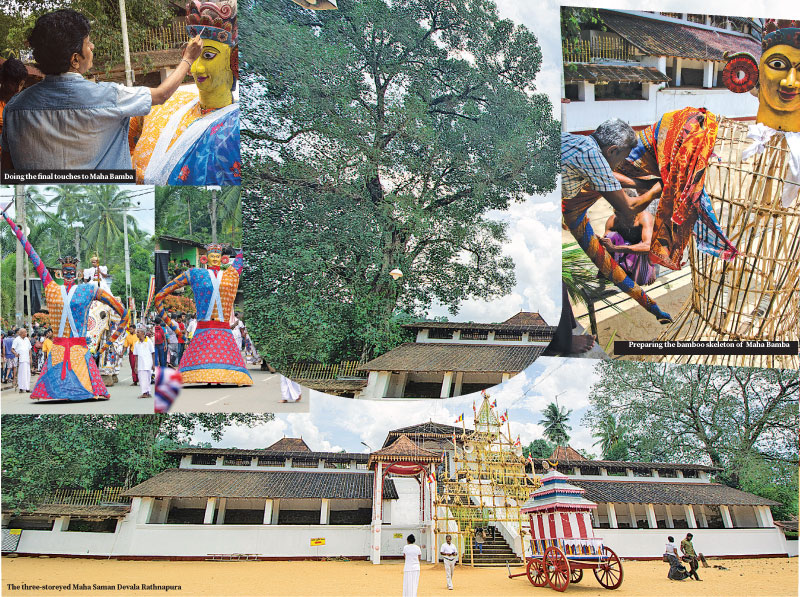
I normally visit the Maha Saman Devala with my family at an auspicious time before the commencement of the annual perahera every year. Armed with my Nikon camera this year too, I captured the pre-preparation of the pageant and found the place a hive of activity, especially, in the evening.
The entire venue is packed with spectators; and excitement grows as the dancers take turns to swirl and twirl and make the whole area alive with sounds and colours. More and more elephants join, and as the drum beats echo more people come to view the perahera.
However, many features of the annual pageant have been curtailed this year due to the Covid-19 pandemic which swept across the globe. The procession this year was viewed by a lesser crowd than on previous years. The Covid-19 outbreak has affected most of our historical, cultural and social ceremonies during the past six months.
A huge two-faced figure of Maha Bamba with a serene face on one side and a fierce face on the other side is a unique feature of the annual perahera of the Sabaragamuwa Maha Saman Devala in Ratnapura.
According to historical evidence, the Maha Saman Devala perahera began during the reign of King Parakramabahu VI. However, King Sitawaka Rajasingha added the Dalada Perahera to the pageant.
Thousands of spectators, mostly children are mesmerised by the magnificent creation of Maha Bamba Kolama, a unique feature in Sabaragamuwa that can only be seen in the Saman Devala perahera. The 15-foot-high figure is usually carried at the head of the perahera as Peramune Rajakariya (frontal duty) which adds beauty to the age-old procession.
It is believed that this figure depicts the character of King Rajasingha I who was considered to be fierce like a demon in anger and pleasant as a deity to the virtuous.
The two-faced figure has more features – five cobra hoods on the demon face, a sword in one hand signifying ferociousness, while the other hand is placed on the hip with a bunch of flowers signifying virtuousness.
Making the Maha Bamba figure is known as Peramune Rajakariya. It has been assigned to the Kolakkara caste of community who live in Kolombogama, a village near Nivitigala, 24 kms from Ratnapura. In ancient times, the king granted Nindagama to the people of the Kolakkara caste to create and perform the Maha Bamba Kolama in the perahera and thereby maintain the tradition. Today, the descendants entrust the creating of this figure to the most experienced persons.
It is not an easy task to create this 15-foot high figure which needs at least two people. Every year, they start to create the figure at an auspicious time prior to commencing the perahera. First, they build the bamboo skeleton and fix the two-faced mask which is kept safely in the Devala store room. Thereafter, the figure is dressed in 15 colourful saris, which takes ten days to complete.
The creators themselves carry the Maha Bamba in the procession, walking and rotating it from inside. It is carried four inches above the ground on the five nights of the Perahera. A small hole is made at eye-level of the figure, and the person walking close to the figure shows the way and is ready to help the insider who is carrying the figure. When he is tired, he keeps it on the ground for a few seconds to rest
After the completion of the procession, the clothes, hands and the two-faced mask are safely stored in the Devala to be used at the next Perahera. The rest of the bamboo skeleton is thrown into the Kalu Ganga.
The three-storeyed Maha Saman Devala of Sabaragamuwa stands majestically on a small hillock on the banks of the meandering Kalu Ganga in a picturesque setting, two kilometres from the Ratnapura town on the Ratnapura-Panadura road.
The Devala had been originally constructed during the Dambadeniya period (1236-1270 AD) and restored during the reign of King Rajasingha I of Sitawaka.
In the rampart in front of the devala is a plaque
depicting two warriors symbolising the destruction caused to the devala by the Portuguese. A large number of visitors and pilgrims visit the devala, especially during the
perahera season.

